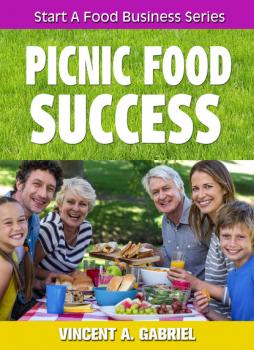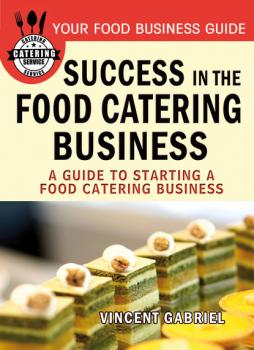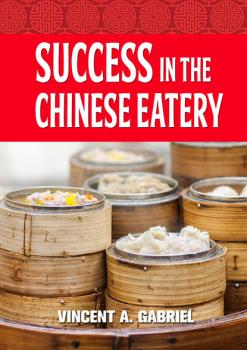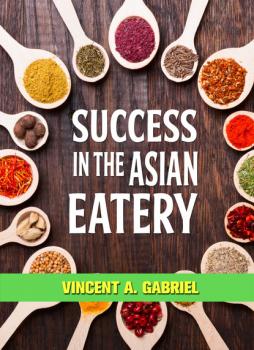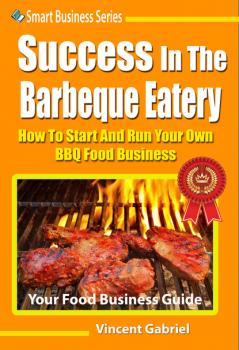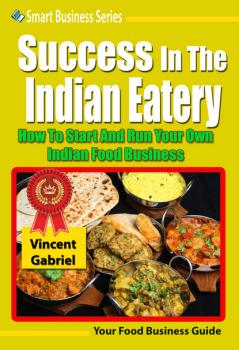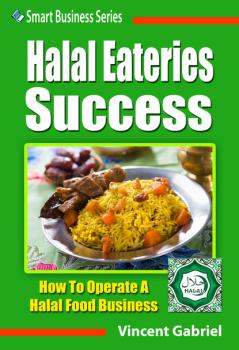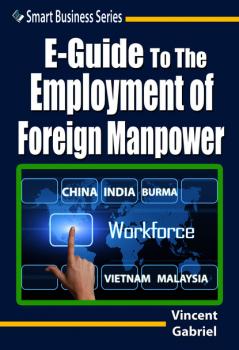Vincent Gabriel
Список книг автора Vincent GabrielPicnic Food Success
This book Picnic Food: Success represents a new trend in 2016 when more and more families have begun to appreciate the outdoors. What is available should be treasured because the island of Singapore is simply too small to have too much open space for a population of more than 6 million<br><br>The outdoors should be appreciated Singapore style and that means a good meal should be included. <br><br>Entrepreneurs have recognized any opportunities in providing a special kind of food and drink Ð something that will be able to withstand the weather, high humidity and not spoil too easily and cause stomach upsets or in the worst case, food poisoning.<br>
SUCCESS IN HEALTHY EATERIES
Do you have a passion to eat and live healthy? <br><br>Are you a good manager of people? This business will likely require you to coordinate several helpers during busy periods.<br><br>Are you well-organized enough to prepare an array of foods and keep them ready for a client rush (i.e., lunch hour)?<br><br>If you do, health food eateries may be for you. The trend to eat healthy is strong and many are looking for fast and healthy food instead of unhealthy traditional fast food like burgers and pizzas.<br><br>
Success In the Food Catering Business
This book marks the fact that food catering has gone mainstream. At one time associated with organizers of seminars and conferences as a means of bonding the attendees of the event or to provide convenience so that each person who attended did not have to look for his own food. The food catering business is very closely connected with the industrial economic development of the Asian economies that underwent transformation in the late 1940's and continues up to today. The food provided at the seminars were arranged in three groups. A coffee break was held in the morning with a range of light snacks that included a major starch like fried rice or fried noodles. The lunch menu was clearly more extensive with a soup, a vegetable dish, a meat dish, a fish dish and a dessert. Care had to be taken to avoid offending anyone. Pork was not allowed nor was beef. The only meat served was chicken and it came in different forms: fried, roasted, boiled, with sweet and sour sauce, or with black pepper sauce or simply hot and spicy. The last meal was the tea break. In a way this meal was a milestone because the people of the Asian economies never had an afternoon break as they were expected to go home at 5 pm and have a meal at home at 6 pm. With the tea break it became a custom to have dinner or the evening meal later at 7 pm.<br><br>The food provided at seminars went beyond the training room because it was convenient to have meals provided for, cooked by someone else. The idea that developed was called parties brought to you.<br><br>Today sixty years after the introduction of the first seminar catered meal food catering is the norm for people wanting a party at home to celebrate a major feast or a personal milestone event like the birth of a baby or a wedding.<br><br>Food catering has also become an event related to hospitality and appreciation. The mourners at a funeral wake are grateful to those who come to pay their respects and food is now catered to provide for these guests.<br><br>In this book the author takes the approach that food catering must grow beyond its present roots and move out to become more mainstream in the form of a meal for a social gathering like that around a steamboat.<br><br>Food catering has also the responsibility to maintain the health of a community by observing the rules of being: <br><br>Less salty<br><br>Less oily<br><br>Less sweet<br><br>Free of transfats<br><br>Free of gluten<br><br>Free of MSG<br><br>And other Chemicals.<br><br>Food catering becomes a mainstream food by being available and by being healthy.
Success In the Chinese Eatery
The sale of food by the chinese Eateries has undergone the full cycle in North America, Europe and Australia.<br><br>When the first Chinese workers came over the Chinese Eatery served to bring to the hungry men what they would eat if they were home. The basic noodle dish with a little bit of meat sustained many for a long time.<br><br>The noodle captured the attention of foreigners and soon they discovered the subtle taste of Chinese cooking and became addicted, leading to the place of Chinese food as one of the most popular items in the taste of non-Chinese. In time the food became more and more what the non-Chinese customer wanted.<br><br>The rise of the wealthy Chinese tourist has revived the standard of Chinese working outside of China. This book serves the purpose of teaching the non-Chinese how to please the Chinese diner and to please him with that unique blend of Chinese cooking styles, using non-Chinese ingredients, in a non-Chinese kitchen and serving Chinese customers from China.<br><br>It has been a long learning journey to come so far but the end of the chinese Eatery bringing everything edible to the world has been reached.
Success In the Bakery Eatery
The Bakery Eatery marks the biggest change in the Asian diet. Five years ago, Asians ate rice only and bread was considered the food of the foreigners. The French introduced the baguette, the Portuguese the tart to Macau, the Spanish introduced the Pandesal to the Philippines, the Dutch the King's cake that became the Kueh Lapis. All these introductions have been important but suddenly:<br><br>* Asian affluence<br>* Need for variety in food<br>* Need for some food less starchy than rice<br>have caused rich communities in the cities of Asia like Shanghai, Tokyo, Hong Kong, Singapore, Mumbai and the Arab Middle East to demand Western style bakery products.<br><br>There was a time when the common supermarket bread, the tinned fruitcake, was considered chic but not now.<br><br>You have this grand opportunity to use your baking skills and tap into this market.<br><br>I have taken the path of least resistance by introducing bread as the main item of breakfast and the Bakery Eatery as the place for all day breakfast.<br><br>I have also gone one little step forward by going into sandwiches, pizzas, savoury buns and others because this will be the direction you move to grow the bakery eatery into a wide spread food offering in Asia.<br><br>The potential for growth in bakery products is limitless, as Asians become more globalized consumers. They have been introduced to burgers, to waffles, to pancakes and sandwiches and they are asking for more.<br><br>What is needed is a creative baker with ideas to tempt the taste buds.<br><br>Asia has much contribute. Asian spices have tickled the taste buds in the rice dishes. With a little experimentation these spices can be applied to bread.<br><br>Asian beer and wine have been paired with rice dishes. With some trial they can be paired with the bakery products.<br><br>Asian ways of preparing meat and fish and vegetables in curry, soy sauce or roast or tandoors can produce items that can go with bakery products. The curry puff is one simple example.<br><br>I wish you every SUCCESS on your bakery adventures and I know that the diet of Asia would be more varied because of you.
Success In the Asian Eatery
This book is written for the Australian, American, European eatery owner who wants to cater to the 8 million Chinese who tour these countries and the 5 million Indians who travel.<br><br>I have taken the approach of modern contemporary cuisine that Chinese and Indian tourists will want to eat and towards that aim I have included:<br>A tutorial on spices used<br>A food stop on interesting food that Asians like<br><br>I have left out other cuisines of the Asian continent that are equally important and special like the cuisines of the Japanese<br><br>the Malay<br><br>the Arabic<br><br>the Thai<br><br>the Burmese<br><br>the Vietnamese<br><br>My wish is that you enjoy yourself, serving the best food to people seeking the comfort food of home.
Success In The Barbeque Eatery
The Barbeque Eatery is the institution that the locals find as the defining mark of the expatriate Australian and American communities in their own country.<br><br>If there is one expatriate, he sends home letters and postcards. If there are two expatriates they set up a Sunday service. If there are three expatriates then after the worship service, they set up the barbeque.<br><br>In a way the Barbeque represents the stage when the expats consider the foreign country no more foreign than their home.<br><br>They have been accepted by the local community and they can gather to enjoy themselves in a way that is special to them.<br><br>This book takes the approach of expats introducing the barbeque to the locals. Many local communities have the barbeque but none has developed such a rich food culture related to the barbeque.<br><br>The food culture would be less rich if not for the addition of the barbeque and the social life that grows around as locals and the expats mingle over good food.
Success In the Indian Eatery
The author focusses on the delights of the food to be offered to the customer.<br><br>"Indian" food is meant to excite the senses, as it is colourful, it is tasty and making it is a joy. To the food entrepreneur indian food causes so much joy to you that I have included Unit 13 because I am afraid that the joy will carry you to beyond the limits to sheer exhaustion and a sense that you or your food is not fully appreciated.<br><br>So you need to be on guard against those who only choose one aspect and push that one aspect to its ultimate end. I am referring to those who misinterpret Indian food as being chilli hot. The truth is that chilli is just one aspect of that food. Other interpretations may include the slowness of the cooking. Another aspect of Indian food is to provide a large variety of fresh food from fish to vegetables to meat and to fruit.<br><br>All Indian food is about communal and personal enjoyment. <br><br>Keep up the good work of spreading the sensual joy of Indian food to the far flung corners of the world.<br><br>I wish you every success in your endeavours.
Halal Eateries Success
One of the most important aspects of food history has been the internationalisation of halal eateries. The affluence of the local Muslim market has attracted sellers from the Middle East, Pakistan and the Islamic communities to put up their food products.<br><br>If this trend goes on, Singapore can acquire the hub status of being the Halal Eatery of the world with a focus on the untapped market of China and the central Asian oil-rich republics.<br><br>My hope is that reading this book will inspire you to introduce halal eateries into yet untapped areas. Of all the F&B opportunities the halal food business, is currently, one of the best opportunities, not only in Singapore but also in China, and the oil-rich states of Central Asia. As my title indicates: "Welcome World", and I hope you will taste Success soon.<br><br>An ideal guide for those who wants to setup a halal food business in Singapore.
E-Guide To The Employment of Foreign Manpower
The Singapore economy has undergone drastic changes. There is less and less of the traditional activities. A simple example is that Singapore has lost its place as the No. 1 port, yet Singapore remains a shipping and maritime hub.<br><br>Europeans find Singapore a convenient connection to the fast growing business opportunities of China and India and now Burma (also called Myanmar).<br><br>India and Burma represent the new frontier opportunities — What China was two decades ago of underpriced assets and a labour force willing to put in the effort.<br><br>Amidst this background the Singaporean worker Gen X vintage is rewarded according to his/her performance. The old cap on wages has been jettisoned. The gap between the average high performer who earns $50,00 and the cleaner who earns $850 is too great to be acceptable.<br><br>Drastic steps are being taken to bring the definition of low wage to be not less than a $1,000 a month. Creative steps are being undertaken by the government, the labour movement and employees to train and to do whatever is needed to bring up and maintain that wage level.<br><br>This means that foreigners on work permits should not be brought in, as they tend to cause wages to fall unless these foreigners earn at least $1,300 a month.<br><br>The relationship between foreigners on work passes and Singaporean workers (at these entry levels) is a love-hate relationship. On the one hand Singapore love to have "maids" (FDWs), marine contractors, labourers, healthcare workers, but on the other hand the 'S' pass holders, the EP holders, who compete with tertiary-educated Singaporean at entry levels the relationship is not so receptive. Young graduates must be given <br>a chance to enter the workforce.<br><br>This book explains the employment regulations of hiring foreign manpower in Singapore and teaches how you the employer can comply with the Singapore labour laws.
